A 4-Day Bangkok Itinerary For Every Travel Style

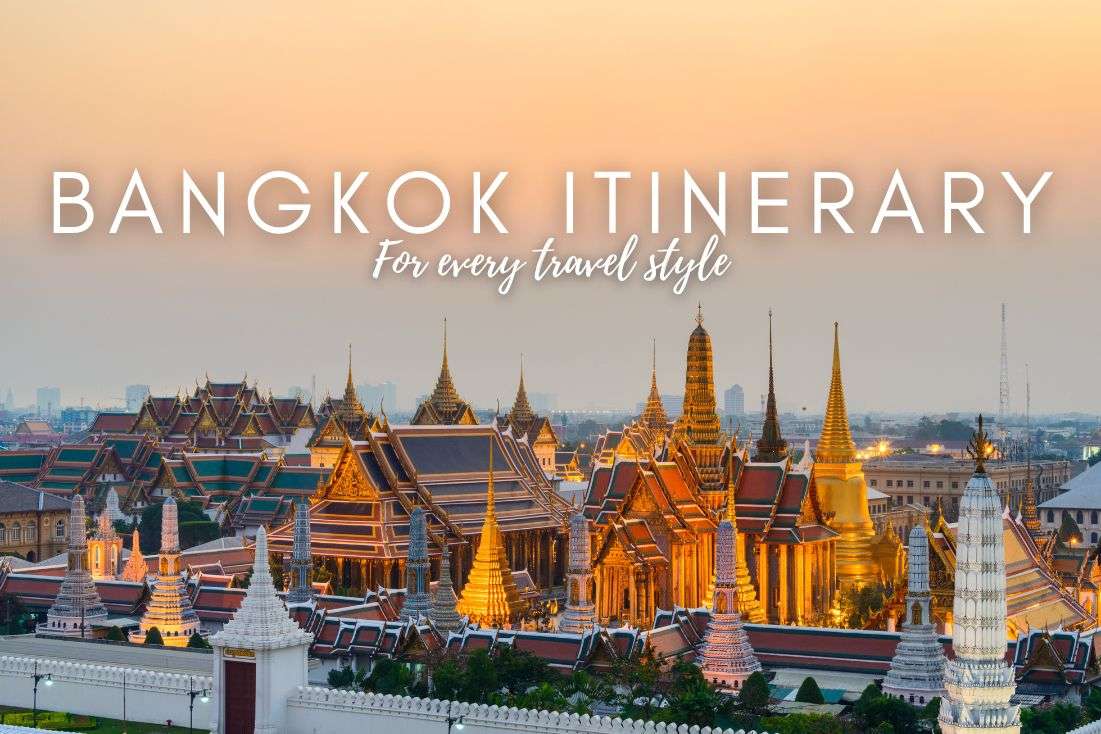
Bangkok is like pineapple on pizza—you either love it, or cringe and feel like you need to reconsider who you’re friends with. I’m team Bangkok all the way and am always excited to visit, though for some reason the strongest association I have with the city is the smell and bad air quality (the first time I flew in I thought we’re having bad luck on a foggy morning… silly, naïve little me, that was just standard low visibility caused by pollution!). Hey, we don’t choose what we love, and I’m head over heels for smelly, sweaty Bangkok!
This itinerary is perfect for first-time Bangkok visitors, covering all the top tourist sights, but making sure to not just scratch the surface and make sure you have the best Bangkok trip EVER—I’ve been to “the Big Mango” (love that nickname!) times, and I’ve made sure to incorporate all of the places that you can’t miss based on my personal experience.
All my experiences from Thailand can be found here.
How many days do you need in Bangkok?
Like I mentioned, I’ve been to Bangkok many times, so I feel qualified to say that 4 days in Bangkok is the sweet spot—3 days would be the bare minimum where you’ll leave wishing you took a day off the islands in the south and added it to Bangkok instead (can you tell I’m not a big beach person?), 5 days might seem like your days are getting a little repetitive or that you’re spending too much time in malls and cafes—you can do that at home, you know?
This is an itinerary for 4 full days in Bangkok.
Who is this Bangkok itinerary meant for?
My travel style is “cram as much as you can into each day but take your time in each spot and don’t forget about coffee breaks”. I’m not traveling just to check things off my Bangkok bucket list, I try to immerge myself into the culture, learn about the history, and enjoy the city’s vibe, too. If that sounds like you, you are the ideal audience for this article.
If you have a slower travel style or are at the end of your Thailand itinerary and just can’t muster up enough energy for 4 packed days, you could take the first 3 days of this itinerary and spread the stops out over 4 days, making the decision to skip the Ayutthaya day trip this time around. That would give you a more relaxed 4 days in Bangkok.
You may also be visiting Bangkok at the beginning and end of your Thailand trip, since it’s more likely than not that you’re using Bangkok to fly in and out of the country. In that case, you may split this itinerary into two parts to cover both of your stops in Bangkok—it all depends on the logistics of your trip. For example, on my last trip, I just had a day in Bangkok at the beginning of our trip, so I stayed close to Phaya Thai (Pratunam area) and covered Day 2, and then at the end of the entire trip I stayed in Old Town and did all the other days then.
Where we stayed in Bangkok: Old Town or Pratunam
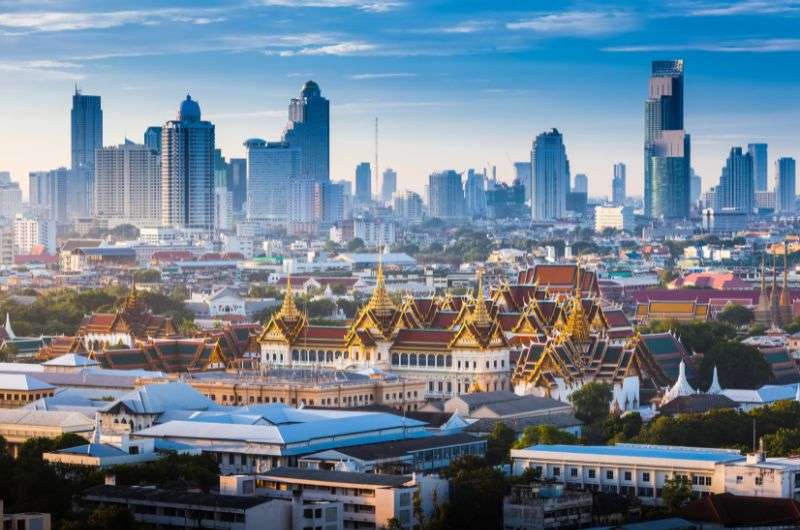
Staying in the Old Town is most convenient for most trips, though being close to the Airport Rail Link makes sense in some cases
I spent an embarrassingly long time choosing the best place to stay in Bangkok for our last visit, because I have this thing where I NEED to find the spot that makes the most sense logistically or else my brain would explode. The problem is, Bangkok is a big place! And the best places to see in Bangkok are not all in one spot.
In the end, I decided that staying in the Old Town is the best option for any first time Bangkok itinerary, because it’s in the middle of the tourist action, and even though it’s not on the BTS SkyTrain, you can easily get around using the boat or taxis.
Samsen Street Hotel is a fun, hip 4* hotel with shows movies on the huge screen above the pool every evening. It even has balconies surrounding the courtyard with the pool that are made to sit on, facing towards the pool, with cool seating cushions inviting everyone to join the fun. The breakfast buffet made me eat way too much every morning and the receptionists bent over backwards to make us feel welcome.
If you, like most travelers in Thailand, have a stop in Bangkok at the beginning and end of your trip, it might make sense to spend one of those Bangkok stops near the Airport Rail Link—it’s an easy, cheap, and effective way to get to and from the airport. We chose the area around the end station, Phaya Thai, for one of our stops in Bangkok. K Maison Boutique Hotel or Vince Hotel are both really good options in this area.
Overview of 4 days in Bangkok + map

You’ll spend the first 3 days of this itinerary inside Bangkok, and then head out on a day trip to Ayutthaya on day 4.
Here’s what I have in store for you for your 4 days in Bangkok:
Day 1: Grand Palace, Wat Pho with Reclining Buddha, Wat Arun, Asiatique
Day 2: Khlong tour, flower market or anime mall, Wat Sa Ket, Thai boxing match
Day 3: Jim Thompson House, Siam Paragon or other shopping mall, Lumpini and Benchakitti Parks, night market
Day 4: Ayutthaya day trip
Day 1 of Bangkok itinerary: Grand Palace and famous Old Town temples
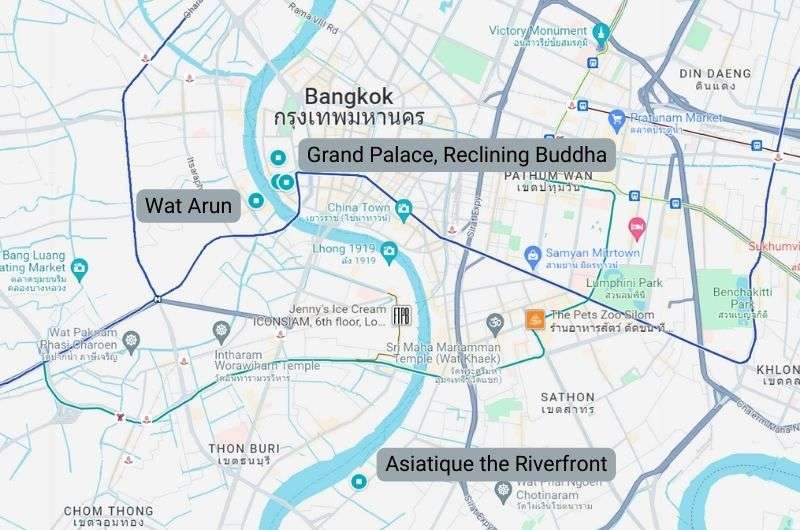
A map showing the stops on day 1 of your Bangkok itinerary. Hop on the Chao Phraya river boat to get all the way down to Asiatique!
Main sights visited on day 1: Grand Palace with Emerald Buddha, Wat Pho and Reclining Buddha, Wat Arun, Asiatique
Restaurant tips: Hello sit down in Old Town| Crystal Grill House in Asiatique
Hotel recommendations: Samsen Street Hotel
Today, you’ll be spending your time in Bangkok with some pretty important people, like the Emerald Buddha and the reclining Buddha, so make sure to dress the part! Keep your shoulders and knees covered (yes, even the men this time), don’t wear leggings, jeans, or flip flops (or other shoes with no heel).
Head out early to get to the Grand Palace by 8:30 am for best results, i.e. least crowds and least heat. Because there will be plenty of both, and it ain’t pleasant.
Day 1, stop 1: Grand Palace
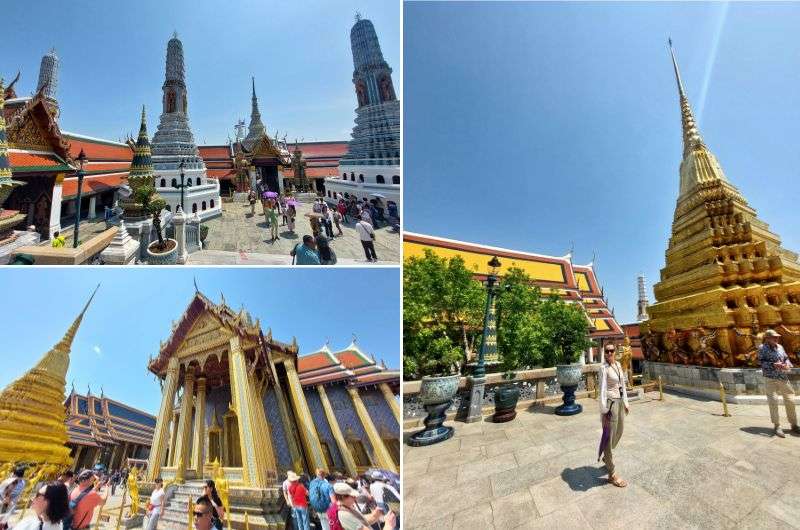
The Grand Palace is just the place to enjoy the beautiful, majestic temples and pose in front of them
Distance from Samsen Street Hotel: 2.5 km (1.6 mi), a 10-minute drive
Time spent there: 2.5 hours minimum, up to 4 hours if you’re really into it
Price: THB 500 (USD 13.50) + THB 200 for audio guide (USD 5)
Opening times: 8:30 am–3:30 pm
Kick off your Bangkok trip with a visit to the iconic Grand Palace, the city's most dazzling landmark. Since 1782, it was the official residence and work base of the Kings of Thailand until the early 20th century. Now, it stands as a shining symbol of Thailand’s rich history and culture, drawing visitors from around the globe—that’s you and me both, sister/brother, and about 8 million others each year! It also holds several significant ceremonies and state functions every year.
I’ve been to the Grand Palace a few times now and it never ceases to impress me. Last time, thanks to the incredible heat, it literally almost made me faint! But I managed to wipe away the sweat from my eyeballs and get another proper look at the place, and yes, it is still fabulous.
Getting into the Grand Palace
First things first, when you get to the palace, you’ll see police presence outside in the streets around the palace. This is standard and no reason to panic or believe the scammers when they approach you and start telling you that the Grand Palace is closed today (due to some make-believe Buddhist holiday or ceremony). They then tell you that it’s your lucky day because they can take you on a boat trip instead! Cheap price! It’s not closed, ok? It’s never closed (if in doubt, check the website).
You’ll also meet people selling elephant pants because yes, tourists still arrive at the Grand Palace in shorts. Then there are the guides, which I haven’t tried, but if you do, make sure to try to have a proper conversation with them first to see if you can understand them and if they haven’t just learned a few English sentences that they repeat like a radio. We got the audio guide and that worked very well.
As you head into the Grand Palace—starting in January 2024, the tourist gate has been changed to Mani Noppharat gate—there will likely be a line at the ticket desk, though hopefully, you won’t run into the mayhem I did in 2019 where the line was for what seemed like kilometers outside the gate. I turned away. You can also buy tickets online now, which could save you waiting time when you get to the Grand Palace.
My top tips for visiting the Grand Palace
- It rarely closes, so don’t believe scammers that try to tell you otherwise. Just walk to the ticket desk and see for yourself.
- If you forgot to wear pants that go all the way down to your ankles, you can buy nifty elephant pants from a number of sellers before the gate. Or, you can wait in another line inside to rent a sarong.
- The heat heats extra strong at the Grand Palace! If you have a Thai phone number, you can rent (for free) and umbrella, which I highly recommend, because there aren’t a lot of places to hide from the sun.
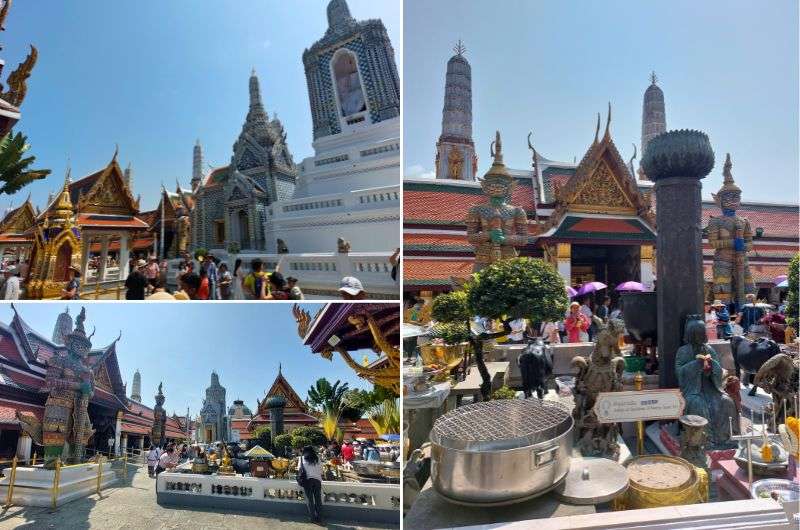
It's quite a distance to the first stop. You’ll shuffle along with a crowd of people before finally arriving at the Emerald Buddha
You’ll then go through metal detectors and your clothes will be looked at as you shuffle along with the 68,521 other people towards the first palace buildings—it’s a surprisingly long walk from the gate to the first stop! Along the way, you can rent a sunbrella (for free) at a desk along your shuffle, which I highly recommend. They need you to give them a Thai phone number and sign a sheet to do so.
Finally, keep scooting along with the sea of other visitors until you see a desk with audio guides. You’ll pay THB 200 (USD 5) for the guide and need to leave your passport or credit card as collateral, and they explain that you’ll return the audio guide at the other side of the palace complex and collect your passport/credit card there when you do. The only problem with the Grand Palace audio guide is that you have a 1.5 hour time limit on it, which I found to be pretty tight and felt rushed.
Then, finally, in you go! The Grand Palace seems to always be crowded, and it can be overbearing, so come mentally prepared to rub sweaty shoulders and unruly umbrellas with everyone.
The Emerald Buddha
You start your visit with Wat Phra Kaew, the Temple of the Emerald Buddha. On the audio guide, it’s number 8, which is slightly confusing but is caused by the change of entrance gate and they just haven’t renumbered the audio guide.
The Emerald Buddha, which is actually made of green jasper rather than emerald, is way smaller than you’d expect for a guy of his importance!
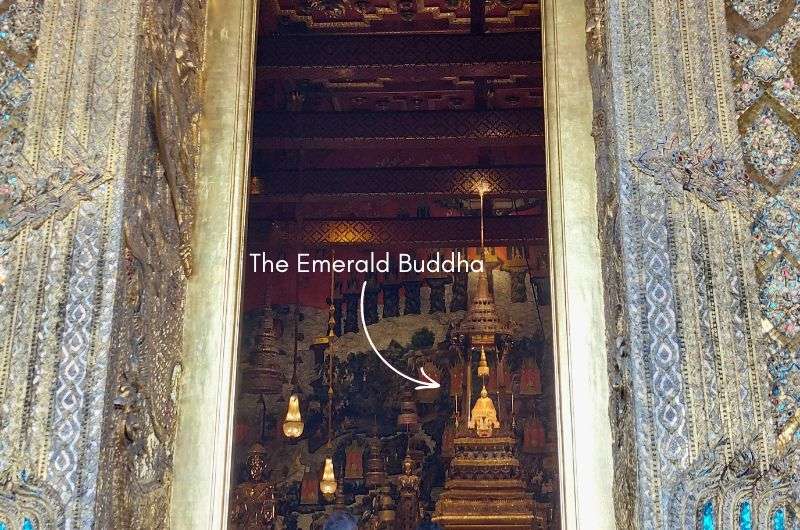
A much smaller Emerald Buddha than we expected...but cool anyway! And wearing fancy clothes, too
Legend has it that the Emerald Buddha originated in India, created by the gods over 2,000 years ago. It traveled across Asia, spending time in Sri Lanka, Cambodia, and Laos before finally arriving in Thailand in the 15th century. It was housed in various temples throughout Thailand, including about 80 years in Chiang Mai’s Wat Chedi Luang, before finding its permanent home in Wat Phra Kaew in 1784, under the reign of King Rama I.
The Emerald Buddha’s wardrobe changes with the seasons—three times a year, to be exact. The King of Thailand himself presides over the ceremonial changing of the robes, which correspond to the hot, rainy, and cool seasons, bringing good fortune to the country.
You’re not allowed to take photos inside Wat Phra Kaew and there are attendants making sure you’re dressed properly before they let you in the door. They also keep the crowds moving, preventing bottlenecks. So instead, there’s a crowd right outside the door trying to take photos of the little guy through the entrance. And then there’s us, answering the age-old question of “does the dog/dragon guardian dude have a butthole?”:
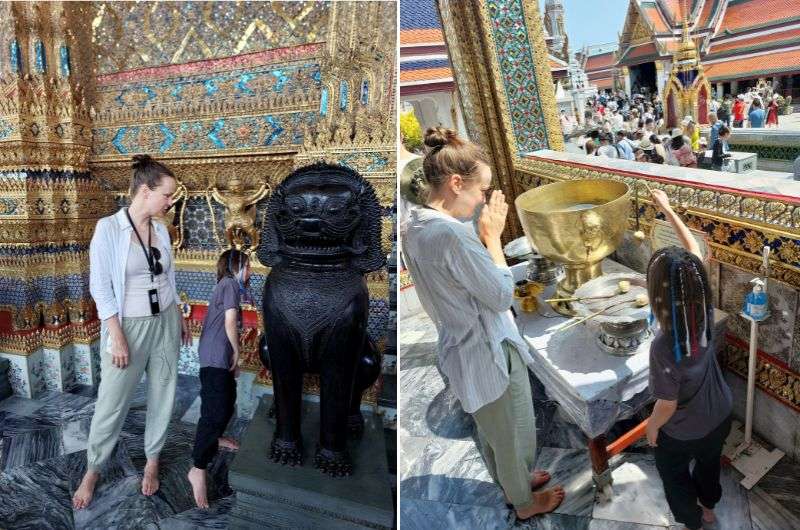
I can report that yes, there is, in fact, a butthole back there. Hopefully the holy water will still work on us after that discovery
Exploring the Grand Palace
After the Emerald Buddha, you can keep going according to the map you get with your audio guide, or just wander if you don’t have an audio guide. There are many buildings to explore and gawk at—yes, you will be doing a lot of staring, because once you see the level of detail and shininess, you won’t be able to pull yourself away. Golden spires, intricate mosaics, and murals that could give the Sistine Chapel a run for its money—the Grand Palace is truly mesmerizing.
Even if you aren’t super into history or Buddhism, there are many interesting facts to tickle your brain with. The audio guide does a good job of telling you just the right amount of detail without boring you, so I really recommend getting it. That said, I would appreciate more time to look around at each spot, but I found myself rushing in order to return the audio guide in time.
Fun facts about the Grand Palace
- Early construction of the Grand Palace used materials from the old capital, Ayutthaya, which had been destroyed in 1767 (you’ll visit the ruins of it on the last day of this itinerary).
- The Royal Pantheon (Prasad Phra Thepbidon) was built during the reign of Rama IV to house the Emerald Buddha, but deemed too small upon completion. Oops.
- Many structures in the Grand Palace complex feature details with symbolic meanings, like the Garuda (a mythical bird), which represents the power and protection of the monarchy.
- Phra Thinang Aphorn Phimok Pavilion: This small pavilion was used as a royal robing place before the king mounted his elephant.
- The Emerald Buddha was discovered in 1434 in Chiang Rai, initially covered in stucco, which cracked after being struck by lightning, revealing the jade statue underneath. The statue's accidental revelation is often seen as a miraculous event.
In hindsight, had my son not been completely melted in the 1.5 hours the audio guide gave us, I would’ve gone to return the audio guide after I listened to all it had to say—this happens annoyingly all the way at the exit of the complex—and then gone back to spend more time inside the Grand Palace. You can easily spend 2 or even 2.5 hours inside, and that’s without the museums.
There are a couple of museums within the palace grounds, like the Queen Sirikit Museum of Textiles, which we unfortunately skipped because we were getting really hungry. But we did tuck into the Wat Phra Kaew Museum. Both museums are included in your Grand Palace ticket, so there’s no extra fee. Not gonna lie, the main reason we went inside was to hide from the sun and hope for AC, but this was actually a nice way to spend 30 minutes. Not only was there AC, but also many historical artifacts. I don’t recall too much information in English, but I was happy to just look at things.
Day 1, stop 2: Wat Pho and Reclining Buddha
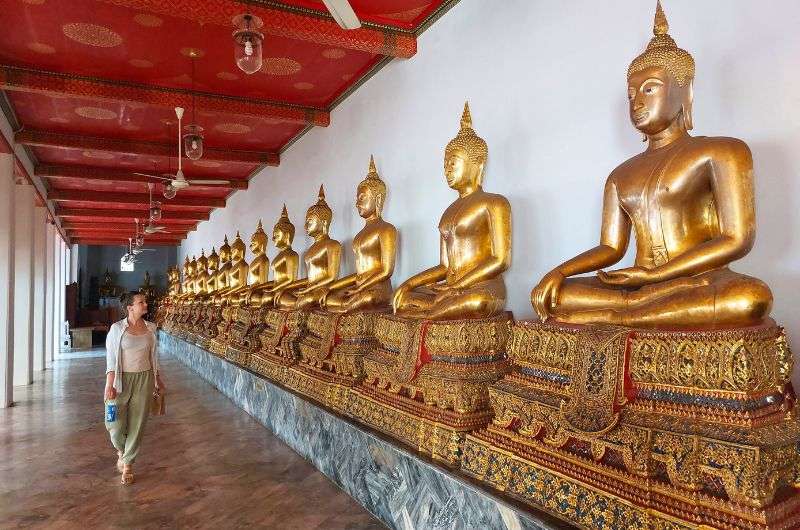
Get ready for a variety of golden statues of different sizes!
Distance from last stop: 1 km (0.6 mi), a 15-minute walk
Time spent there: 1 hour
Price: THB 300 (USD 8)
Opening times: 8 am–6:30 pm
You’ll exit the Grand Palace at the north end, which is a bummer because Wat Pho is exactly on the opposite side of it, meaning you’ll need to walk back all along the exterior of the palace walls to get there. There are tuktuks ready to transport those who’d rather take a 3-minute sit than a hot and humid 10-minute walk.
It’s an uneventful walk as you’ll be passing a lot of navy offices and parking lots, but luckily there are some big trees trying to help keep you alive, err, I mean shaded.
Visiting the Reclining Buddha
(You may want to stop for lunch before heading inside, see the end of this section for restaurant suggestions). Head to Wat Pho, which is where the famous Reclining Buddha lives. Unlike the Emerald Buddha, this guy is massive! Again, they are strict about dress code, but this time, it seemed they only cared what women were wearing.
It’s a one-way situation at the Reclining Buddha, and before you head in, you get a plastic bag to put your shoes in and you carry them with you inside. It’s hard to stop without getting at least an elbow in your face by someone trying to take a photo, but I get it, the guy is a charmer!
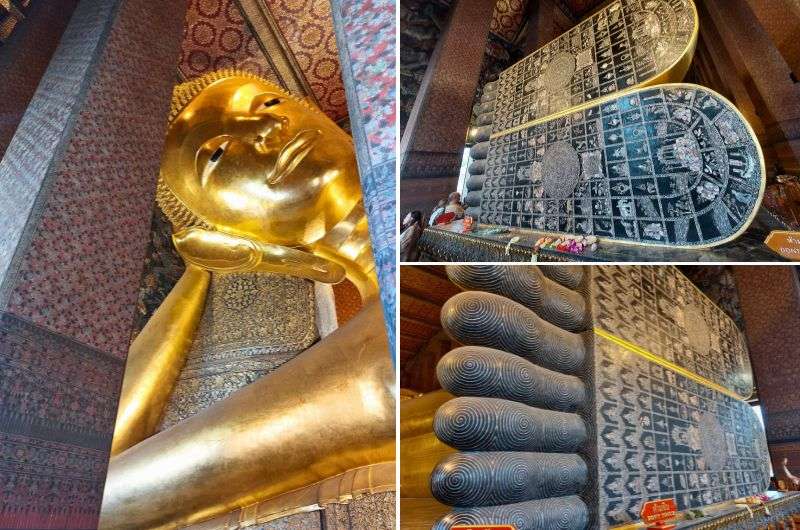
Parts of the Reclining Buddha
I wanted to say that photos don’t do the Reclining Buddha justice, and now I even know why—it’s because he’s impossible to take a good picture of—he barely fits inside his temple! His usnisa (the pointy thing on his head that symbolizes wisdom and enlightenment) literally touched the ceiling. The entire massive statue stretches 46 m in length and 15 m high (151 ft long and 49 ft high), covered in gold leaf.
Built in 1832 during the reign of King Rama III, it depicts Buddha in his final moments before attaining Nirvana. And I have to say he really does exude tranquility and peacefulness—then again, after all those years napping and everyone making me feel like a superstar for it, even I’d probably have a chill expression and the skin of a baby.
The Reclining Buddha's feet alone are 5 m long and 3 m high (that’s 16.4 ft long and almost 10 ft high) and decorated with mother-of-pearl inlays, depicting auspicious symbols.
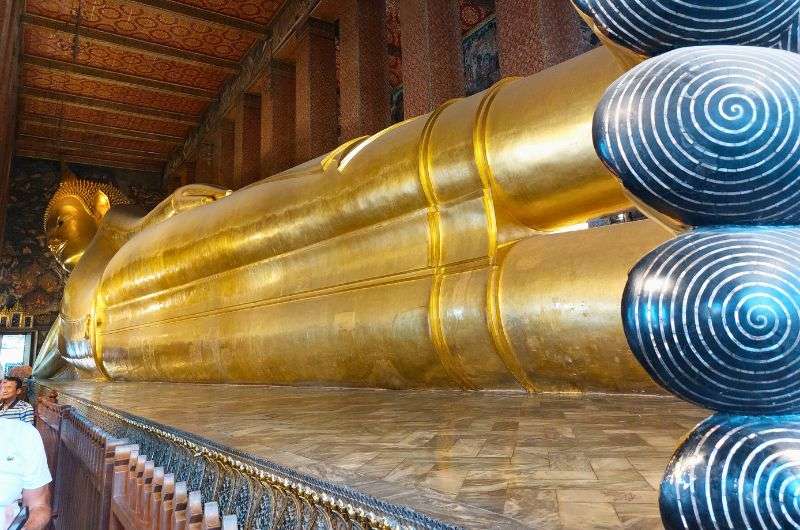
The Reclining Buddha is impossible to photograph as a whole because there are a bunch of columns in from of him. This is my best shot, tiptoes included
You can also get a little bowl with coins to throw into the 108 big bowls lining the temple’s walls for good luck. Since I already tried this at Chiang Mai’s Wat Phan Tao (read all about my stressful experience in my Top Temples in Chaing Mai article), I thought I’d give it another shot, you know, and really put exactly one coin in all 108 bowls—well, I shared sone of the coins with my son. BIG MISTAKE! I stupidly didn’t realize that then I wouldn’t have enough coins for myself, resorting to picking dropped coins up off the ground at the very end, getting panicky when I obviously didn’t have enough to get to the last bowl. I really hope I still get good luck, at least for trying? But wow, this simple little Buddhist tradition has had me sweating buckets way too many times now.
Walking through the Reclining Buddha’s temple will take you about 15 minutes.
Visiting the other parts of Wat Pho temple grounds
Wat Pho is also renowned as the birthplace of traditional Thai massage, with a prestigious massage school operating within its grounds. I didn’t try this, but now you know it’s an option.
Instead, we wandered around the temple grounds and wow, it’s a beautiful place! I was expecting to see the Reclining Buddha and then head out and didn’t realize there’s so much more there to be seen. Rows and rows of Buddha statues in many different rooms and courtyards.
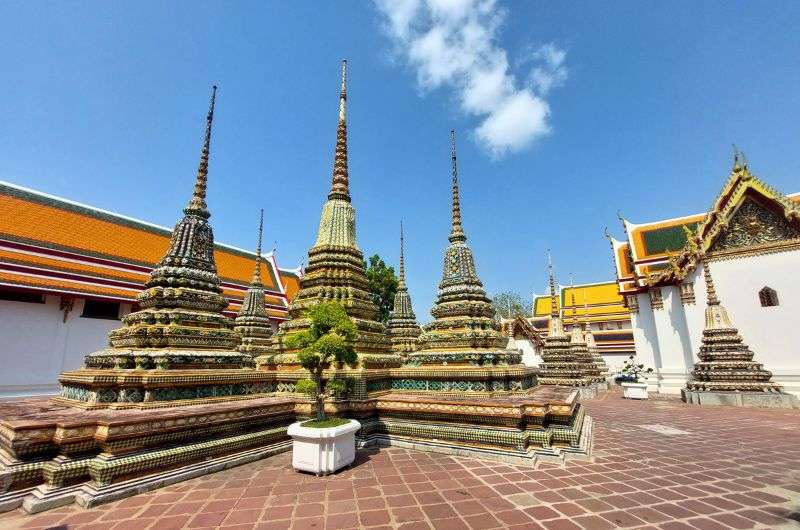
Beautifully decorated chedis at Wat Pho
Beside statues, you’ll also notice 4 large chedis (among the 80 or so smaller ones) that are dedicated to former kings. These chedis are beautifully decorated with colorful tiles, glazed porcelain flowers, and vibrant colors and patterns—they reminded me of the magnificent Wat Arun, an iconic temple that you’ll be visiting a little later today.
There’s also a little shop selling snacks, drinks, and a pretty wide variety of souvenirs, which is where I got my little golden temple bell. You’ll see and hear them all around temples in Thailand, dangling from the edges of temple buildings, sounding all special and temple-y. It makes me giddy to ring mine in my living room every day now. It also makes me miss traveling, but you know what the Buddhists say about impermanence and all that.
You should finish your tour around Wat Pho within an hour.
Lunch break on Day 1: An air-conditioned gold mine
Right out front of Way Pho gate, on the intersection at the end of the Grand Palace walls (Thai Wang Rd. x Tha Suphan Alley), you can choose one of the many restaurants on that corner for a lunch stop. I found the jackpot at Hello sit down by Ladda aunt, which is a very simple, casual Thai restaurant, but it has a secret! AC! They take you back towards the kitchen before pointing you up the narrow stairs, where you’ll find a small room with maybe 5 tables. The food was great, and the prices were surprisingly low given we were sitting right in front of some of Bangkok’s top tourist attractions.
A little break—optional
Now would also be a good time to go freshen up at your hotel, maybe even hop in the pool for a bit. That’s what we did every day at Samsem Street Hotel, and it felt so nice to take a shower and cool down with a drink at the pool. It’s all you need to re-energize and hide from the heat a bit before heading back out.
If you don’t want a break, you’re next stop is right across the river from Wat Pho, so head out now.
Day 1, stop 3: Wat Arun
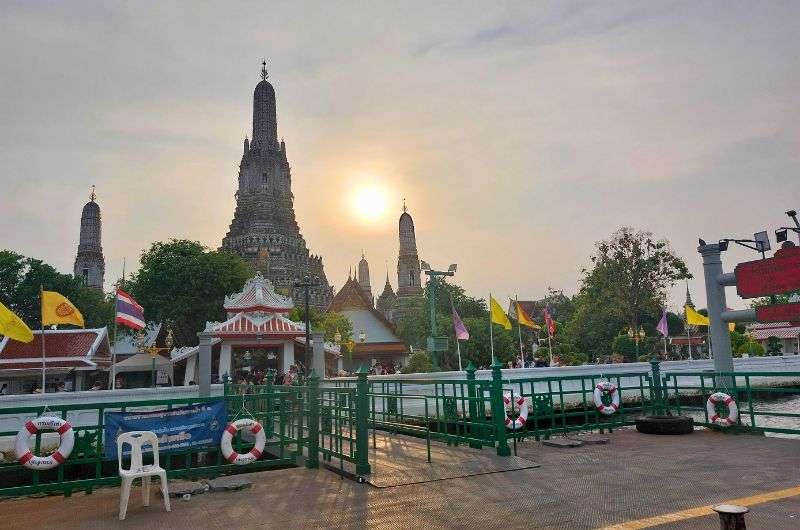
Jumped off the boat right in time for sunset at Wat Arun
Distance from last stop: Right across the river from Wat Pho
Time spent there: 1 hour
Price: THB 200 (USD 5)
Opening times: 8:30 am–6 pm
Wat Arun is known as the Temple of Dawn (or, if you’re brave, by its full name Wat Arun Ratchawararam Ratchawaramahawihan), but you’ll be visiting at sunset, because Wat Arun will make you weep with how magical the place feels as the sun goes down! Especially as you approach it on the boat, the sun getting ready to rest for the night behind it, it’s one of those travel memories that’ll sink in and last forever.

Getting a shot of Wat Arun without feeling like you’ve infiltrated somebody’s photoshoot was impossible. Also, it was plain annoying!
In December and January, which are peak tourist times in Thailand, the sun sets around 6 pm, which is perfect timing since Wat Arun closes at 6 pm. You’ll want to get there around 5 pm at the latest to have enough time to wander around and take your pics. Not only is it simply beautiful at this time, but it’s also what photographers call ‘the golden hour’, which probably explains the hilariously large number of tourists doing photo shoots in traditional Thai rental clothing. It was funny to an extent, but then it just got annoying, because they were all acting like we walked into their personal photo studio, huffing and puffing when anyone tried walking around like a normal tourist. Sorry, guys, but no I can’t wait another minute while you take your 325 photos in this one spot. I know Jan had a similar experience at the temples in Kyoto last year, so it’s not just a Bangkok thing. Sheesh, get a room! A photo studio-type room.
If you’re arriving on the Chao Phraya tourist boat, the stop that you’ll want to get off at is called “Wat Arun”. Easy peasy. More about the tourist boat at the end of this itinerary. If you decided to head to Wat Arun right after Wat Pho, there is a small ferry that makes trips across the river between the two for THB 5 (about 10 US cents).
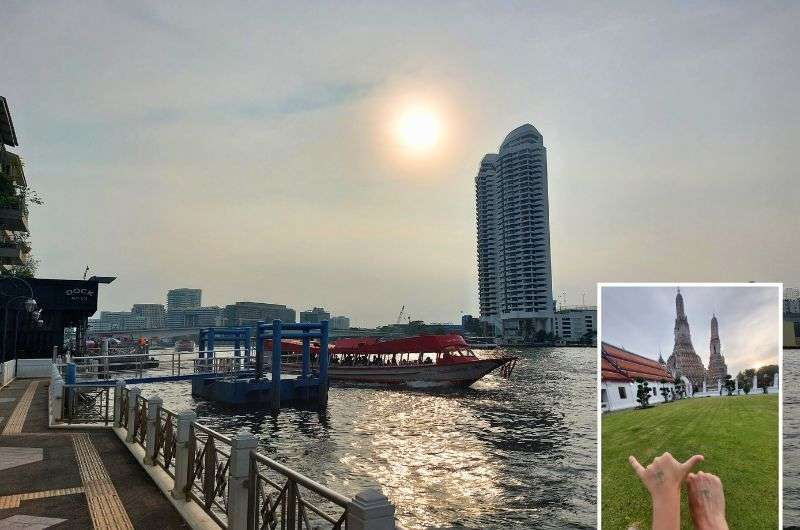
The river cruise was lovely! And the stamps on our hands were considered commemorative tattoos
You’ll pay THB 200 (USD 5) for your ticket, get a stamp on your hand, and head inside. It used to be possible to walk up the steep stairs of the temple, but that is no longer possible, unfortunately. You can now only go up the first level and around the spire from there. Then again, I remember those big stairs and how hard it was to hold my skirt down well enough to keep it from showing off things way above my knees. So maybe this way is safer.
There are a few other buildings and tons of statues around the temple grounds, but you should be saturated and ready to hop back on the boat within an hour or less.
Fun facts about Wat Arun
The temple is named after Aruna, the Hindu god of dawn, symbolizing the temple’s association with the rising sun. Wat Arun’s central prang (spire) stands at approximately 70 m (230 ft) tall, making it a striking feature on Bangkok’s skyline.
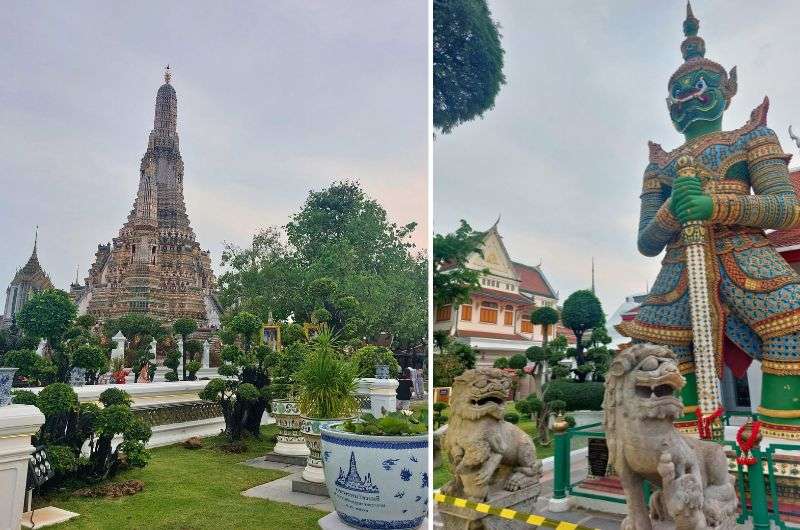
Aruna’s temple
Although a temple has existed on the site since at least the 17th century, Wat Arun as we know it today was significantly renovated and expanded during the reign of King Rama II and completed under King Rama III in the early 19th century. The central prang was seriously heightened during that time, and the intricate decoration with Chinese porcelain and seashells was added, reflecting a blend of Thai and Chinese artistic influences.
The central prang represents Mount Meru, the center of the universe in Buddhist cosmology. The four smaller prangs surrounding it symbolize the four directions. The prang's tiers are adorned with rows of demons and monkeys from the Ramakien, the Thai version of the Ramayana, signifying the cosmic battle between good and evil. The evil sure can make some ugly faces!
Day 1, stop 4: Asiatique the Riverfront

The Ferris wheel in Asiatigue is a must! It’s a slow ride and the views are amazing
Distance from last stop: About 30 minutes on the Chao Phraya tourist boat from Wat Arun
Time spent there: 2 hours or more
Price: 0
Opening times: 11 am–12 am
You’ll finish off your first day in Bangkok at Asiatique, an outdoor mall/entertainment venue to the south of the Old Town, complete with a Ferris wheel, restaurants that range from market stalls to high-end places like the magnificent Crystal Grill House, and tons of shopping options. Asiatique is Bangkok’s biggest and most lively river promenade, and it’s a nice place to end a busy day.
I loved all the little shops at Asiatique, many of them selling cool local products like bracelets, décor items and even shoes and fashion. Then there are the regular souvenir stores with all the “Thailand” t-shirts anyone could possibly want, but you can skip those and still easily have a lot to explore.
The Ferris wheel is the largest one in Thailand, and makes a fun way to see Bangkok at night. If romantic views aren’t your thing, there’s also a haunted house right next door. And, if you’re looking for even more entertainment, get tickets to the Calypso Cabaret show. It is a pretty famous long-standing venue that gets reviews from “it was intoxicating!” to “not sure what I just watched”.
Taking the Chao Phraya tourist boat to Asiatique
The Chao Phraya tourist boat extends its route all the way to Asiatique every day after 4 pm, the last boat leaving from Wat Arun at 6:30 pm. Make sure you’re on it!
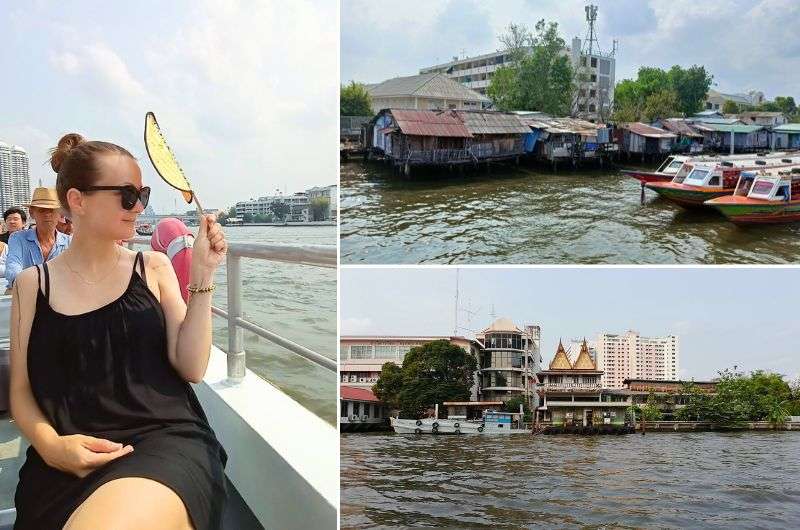
The “bus boat” as I like to call it is an easy way to get around Bangkok, but it also doubles as a tour on the Chao Phraya River
Of course, you can take a taxi to Asiatique, but if you’re on the boat, even the journey is the destination. Seriously, you have to take a trip down the river at least once while you’re in Bangkok and take in all the sights along its banks. Hey, it’s not called the River of Kings for nothing!
A little history: The Chao Phraya River has been a lifeline for Bangkok throughout its history and continues to play a crucial role in the city's daily life. Historically, it was central to trade, defense, and settlement, with early communities thriving along its banks. The river remains a vital transportation route today, with ferries and water taxis crisscrossing the murky waters day in and day out. You’ll see what I mean tomorrow when I take you on a canal tour, where life on the water is very much alive and kicking. It’s fascinating!
This is your last stop of the day, so after you’re all Asiatique’d out, you’ll need to call a taxi (my app of choice in Thailand is Grab) and head back to your hotel. The boats only run up until 7 pm, so you can’t take an evening ride on one of those, sorry.
Day 2 of Bangkok itinerary: The canals, some unique shopping, and Thai boxing
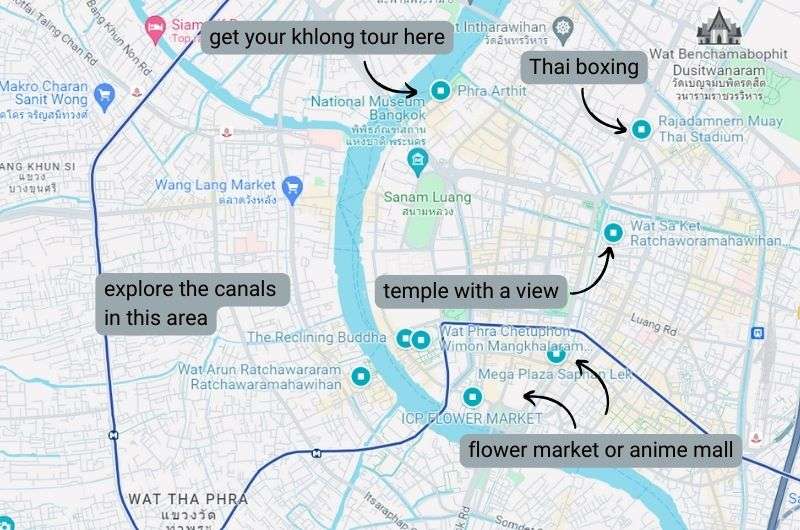
A map showing the stops on day 2 of your Bangkok itinerary
Main sights visited on day 2: Khlong tour, flower market or anime mall, Wat Sa Ket, Thai boxing match
Restaurant tips: MAMA Restaurant | Momo Samsen (simple but superb!)
Hotel recommendations: K Maison Boutique Hotel
Day 2 out of 4 in Bangkok—are you ready? Most visitors in Bangkok never step foot on the west bank of the Chao Phraya River, with a short visit to Wat Arun being the sole exception. But you, you intrepid traveler, will now head inland to where the real people of Bangkok live—the khlongs (narrow canals).
Then, back on the “right” side of the river, you’ll explore Old Town a little more, this time without any temples… and then you’ll head to a temple. How could you not, this is Thailand! End your day with Thai boxing, because, again, how could you not?
Day 2, stop 1: Canal tour through Thonburi district
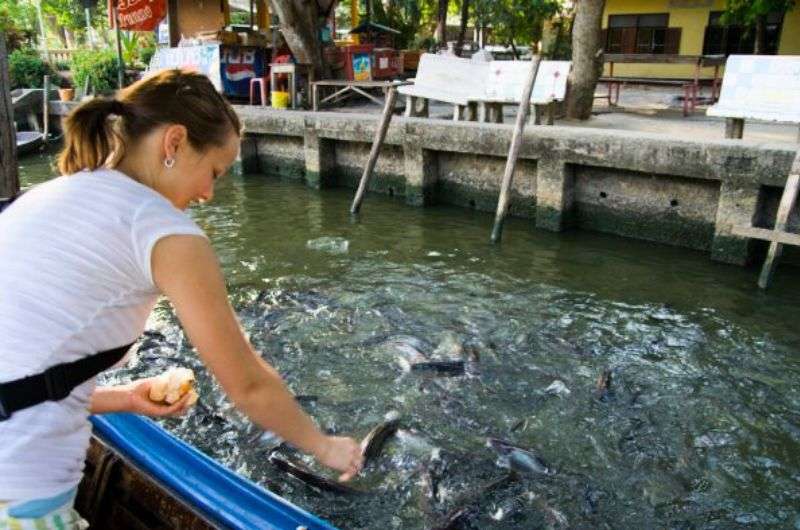
Watch your fingers! The catfish were as big as whales! Photo from a few years ago when I went on the khlong tour (sadly missed it this year)
Distance from Samsen Street Hotel: 1 km (0.6 mi) to Phra Arthit pier where you can find your boatsman, a 10-minute walk
Time spent there: 2 hours
Price: THB 1,500 (USD 40)
After a hearty breakfast, make your way to one of the piers in Old Town. If you’re staying at Samsen Street Hotel like we did, the closest pier to you is Phra Arthit, and it’s a nice little 10-minute walk to the pier from the hotel. I’ve learned that this is one of the best piers to get a khlong boat tour.
I did a khlong tour a few years ago and was really hoping to go again this year, but alas, the heat just beat my family down so much that we ended up giving up on another outdoor activity, instead going crazy in one of Bangkok’s anime shopping malls. BUT! You will do better! I still remember the feeling of floating past wooden stilt houses with TVs on their “terraces”, young children jumping into the water, women doing laundry, and us feeding huge fish with bread we bought from a small merchant’s boat, like we had our own personal floating market experience.
I will describe Bangkok khlong tours in general, because your experience will differ depending on the pier you start out from and the guide that takes you. In true Thai fashion, the tours are all same same but different.
When you get to a pier looking like you’re after a private boat tour, you’ll probably be spotted promptly by someone that can offer you such boat tour. We were approached by a man each time we went to the pier to board the tourist boat, saw one at Wat Arun pier too, and back in the day when I actually went on a khlong tour, that’s also how events went: you walk to a pier, you find a man that looks like he has a boat or the man will find you, and you discuss price and itinerary. Bam! Khlong tour commences.
I did talk to the man this time around for a bit to get up-to-date info about what he’s offering (and I can only assume it’s similar to what everyone else is doing). We showed me a large map of the canals, pointed out the route he’d take us one, and that we’ll stop at a temple and another place I can’t quite remember. The price started at THB 2,000 (USD 54) for 2 hours (for the boat, not per person), but went down to THB 1,500 (THB 40) in a matter of seconds when I thanked him for the info. Had I planned on actually hopping on the boat that very moment, it seemed like we would get the price down even further pretty easily.
On a khlong tour, you take Bangkok’s version of a longtail boat, which is a slim, teak boat that has a colorful plastic ‘roof’ and sides to keep the water from getting on you. You’ll appreciate that as you fly down the Chao Phraya!
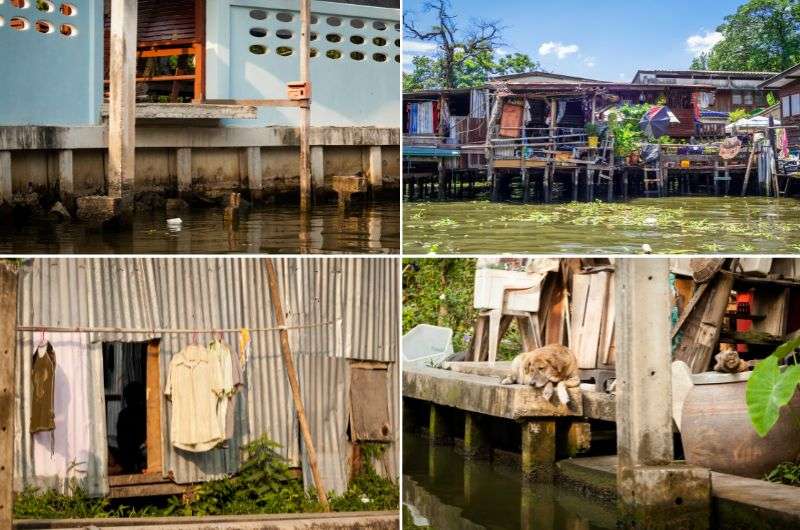
We saw some fancy houses along the river too, but of course I took the most pics of rickety stilt houses and khlong dogs
When you enter the canals of Thonburi district, the boat slows down and you suddenly feel like you’ve entered private property. This is people-watching on steroids! You pass little wooden houses on stilts above the water, some looking like they’re holding on for dear life, and then some fancier houses right next door, because apparently, the poor and rick can live together after all. The contrast within the area and with the touristy part of Bangkok was remarkable. I played a game in my head where I took note of all the appliances that seemed out of place on the outdoor, over-the-water parts of the little houses, like TVs and refrigerators.
And there was life there too, of course—kids playing, adults sitting around or doing everyday chores like laundry or sweeping. And there were khlong dogs and khlong monitor lizards, and even a mailman! On a boat, of course.
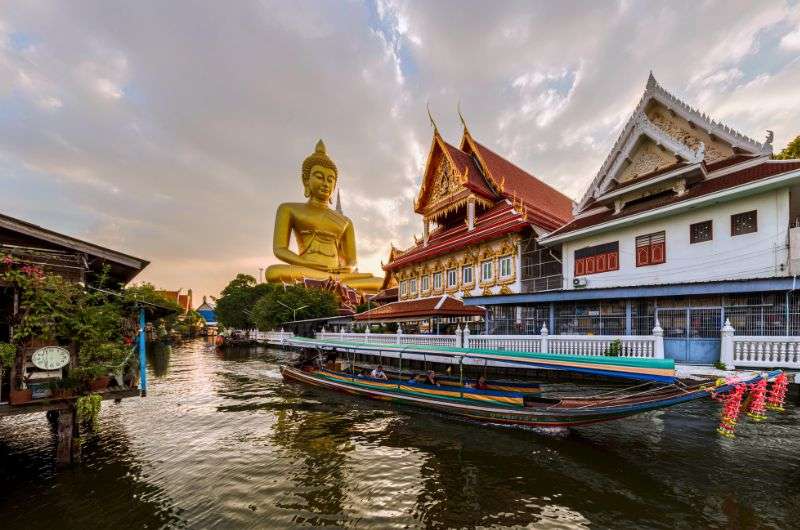
Wat Paknam Phasi Charoen temple with the huge statue of Buddha and one of the khlong tour boats
Every khlong tour will offer to stop at at least one temple—Wat Paknam Phasi Charoen seems to be the most popular one, or, if you are khlonging further south, Wat Sai—, and then another spot, like Baan Silapin artist village, an orchid farm, or one of the many small floating markets (if you’re heading out on the weekend). I remember floating past the “artist houses” on my khlong tour and just telling the driver to keep going, because it looked super touristy. But if you’re up for a coffee stop or even lunch, this would be one place to make those purchases. We just decided to stay on the boat the entire time and were happy just watching the world go by.
One thing to consider if you’re taking a random boatsman from the pier is that they mostly don’t speak very much English, so if you’re expecting a guide, expect again. He is your driver, period.
If you’d prefer a guide or are scared to go out looking for a khlong tour on your own, you can book one like you’d book any other tour, like at your hotel or on Viator or Get Your Guide. Just note that these won’t standardly be a private tour and you’ll be sharing a boat with other tourists.
Day 2, stop 2: Anime mall or flower market
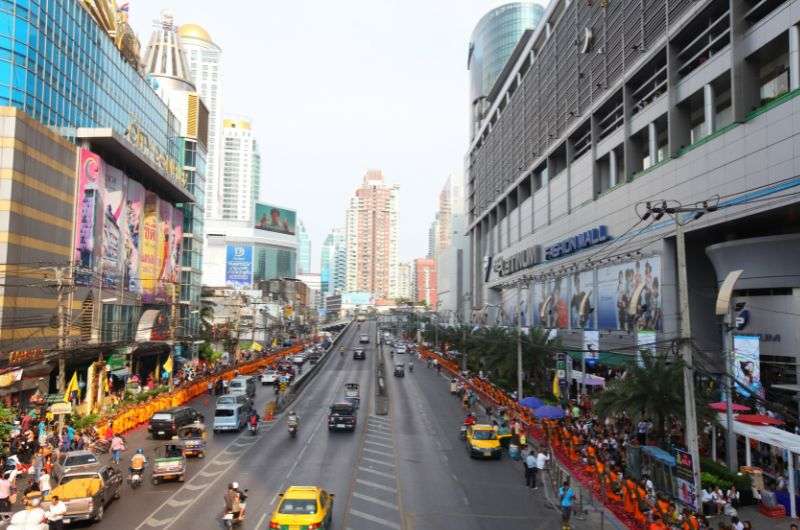
Time for shopping!
Distance from last stop: 20 minutes on the Chao Phraya blue flag boat between Phra Arthit and Memorial Bridge stops
Time spent there: 1 hour
Price: depends on how much you buy!
After you’re back on dry land, make your way (tourist boat to Rajinee Memorial Boat or Grab) to one of the two options I’ve chosen for you: Mega Plaza Saphan Lek, a mall selling all things anime, or ICP Flower Market, a… flower market. Both of these will get you mingling with locals and seeing a slightly less touristy Bangkok.
Before or after your unique shopping experience, it’ll be time for lunch. There’s a gorgeous Indian restaurant (supposed to be the best one in Bangkok!) called MAMA Restaurant that’s roughly halfway between the flower market and the anime mall. Oh, maybe I should mention that you are now in the “Little India” neighborhood of Bangkok.
Option 1: Anime mayhem!
I went to Mega Plaza Saphan Lek because I travel with a little Japanophile, but being the good mom that I am, even I could get into the hype and appreciate a little Totoro and Gundam for an hour or two (I had to pry us away after 2 because I’m a good mom, but not that good). I’m lying just a little bit—I love Totoro and spent a good 45 minutes choosing the right one to buy.

I visited and thoroughly enjoyed Mega Plaza Saphan Lek, and even got myself a Totoro! Check out their Facebook
The mall is packed with one small vendor next to another, and everyone is selling collectibles from every anime movie and show under the sun, as well as some other merch. It is also here that I learned that airsoft guns look very realistic.
Just a heads up, there are also plenty of figurines from adult anime, which is X-rated at the least and cringeworthy on more than one occasion. The placement of some of these anime ladies making questionable life choices in plain sight on an 8-year-old’s eye level kept me on my toes, blocking the large glass display cases with my body in hopes of not corrupting my son’s pure little mind just yet.
If you’re buying, know that gentle haggling is a thing here and that cash is preferred if you’re hoping to get the price down a bit. There are ATMs right outside the main entrance.
There are a few fast-food places on the ground floor if you shop till you drop and need to eat something.
Option 1: Flower overload!
If you prefer colors and fragrances to plastic people and weird creatures, the ICP Flower Market will be more up your alley. It‘s Bangkok's largest wholesale and retail fresh flower market, and an absolute feast for the senses.

Flowers, anyone?
Picture rows upon rows of flowers in every color imaginable, from delicate orchids and lovely jasmine to vibrant marigolds and roses. The market also sells flower-related items like garlands, floral arrangements for offerings, and even some fruits and vegetables.
The flower market is at its best in the early morning or in the evening, when the temps drop and more flowers come out, but I think any time of the day is fine to wander around for a bit. Hey, at least it won’t be as crowded in the middle of the day. Strangely, the flower market is open 24/7. Not sure who needs to buy flowers at 3 am. Just know that if you are after the freshest of flowers, super early mornings are when they arrive, between 4 am and 6 am.
The market has a rich history dating back to the early 18th century. It originally started as a floating market and transitioned into a produce market before becoming the floral wonderland it is today. Strolling through the market, you’ll get a sense of the traditional way of life that still thrives amid Bangkok’s modern hustle.
Day 2, stop 3: Wat Sa Ket
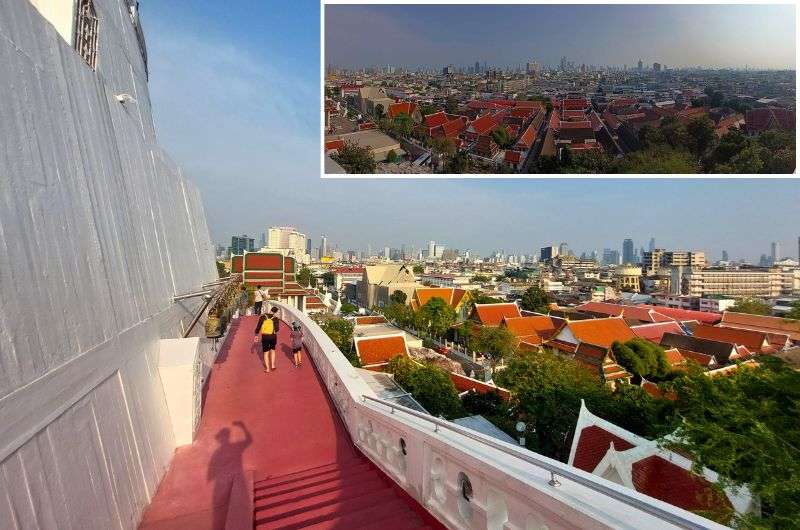
The views get better and better as you walk along the white walls towards the top of the temple
Distance from last stop: 1.5 km (1 mi), a 15-minute walk (we just took a taxi)
Time spent there: 45 minutes
Price: THB 100 (USD 2.70)
Next stop, Wat Sa Ket, aka the Golden Mount. Normally, this temple flaunts a glittering golden chedi that gives it its name, but during our visit in March 2024, it was covered up and closed for restoration. Bummer! Still, it wasn’t a huge deal-breaker since you still get the views that you come here from, even if you can’t go all the way up to the chedi.
The usual temple dress code applies, but luckily, no one was checking too closely. I tried my best to make my above-the-knee dress behave, but as you'll see from the pics, I failed spectacularly. Sorry, folks! Good thing I always carry a cover-up shirt in my bag, it’s a lifesaver for impromptu temple visits and for surviving those North Pole-level AC blasts in Thailand! So at least I could make my upper half presentable and pulled that dress down as low as it would go over my knees.
Everyone raves about the sunset views at Wat Sa Ket, but tonight, you’ll be watching Thai boxers kick and punch each other as the sun goes down instead. So, make the most of a daytime visit—the views are still pretty awesome.

The tip of the Golden Mount is under renovation works at the moment, but at least there’s a model of the whole thing inside
To reach the top, you’ve got to tackle a long, winding staircase (344 stairs to be exact!) that wraps around the temple. It’s a bit of a workout, but hey, there are bells to ring and gongs to gong along the way. The approach to the temple is lined with some pretty kitschy stuff—think neon lights and fog machines over water features with animal statues that look like they belong in a funky garden center. It’s weirdly charming and makes for some fun photo ops.
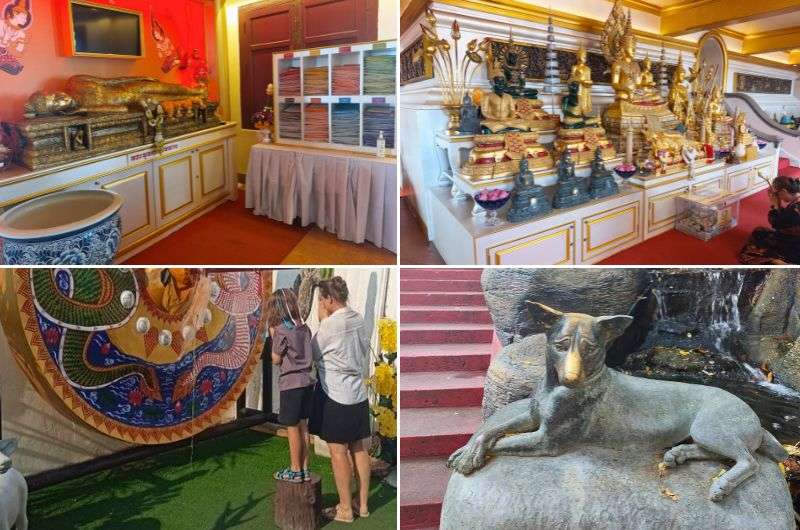
There is a lot to see at Wat Sa Ket. I showed my knees despite trying really hard to make my dress longer, sorry!!
Inside, we stumbled upon a monk giving blessings to a couple while others waited their turn. I almost joined the line but chickened out, not wanting to make a mockery of the ritual. There’s not much to see inside except a few statues, but there is AC! The real highlight is staring out the windows at the sprawling Bangkok views. In times when the golden chedi is accessible, you’d walk further up to the rooftop for open-air views.
Among other offerings, they sell these colorful cloths for each day of the week based on your birth day. I thought I’d snag one as a souvenir, only to find out they’re meant to stay in the temple to decorate the statues. Well, there goes that idea!
You’ll only need 45 minutes tops to see Wat Sa Ket, and then head back to your hotel to get ready for some Thai boxing!
Day 2, stop 4: Thai boxing night
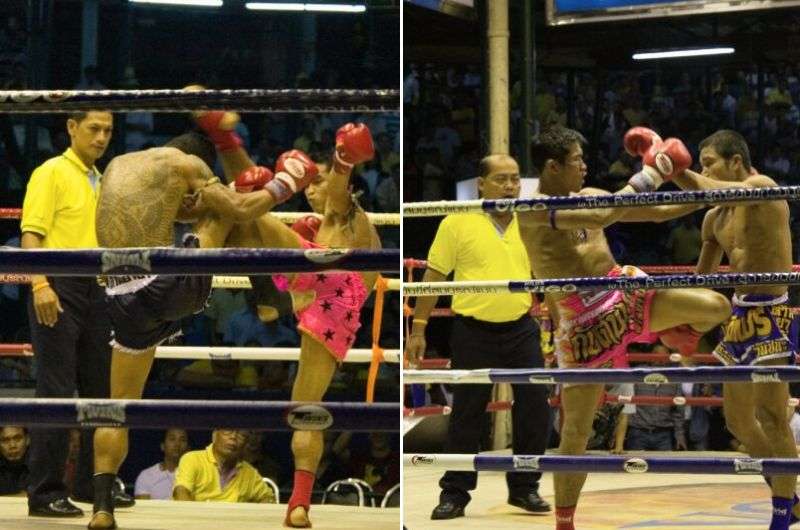
And of course, a Thai boxing match can’t be missing from any Bangkok itinerary
Distance from Samsem Street Hotel: 1 km (0.6 mi), a 15-minute walk from Samsen Street Hotel, but if you’re going straight from Wat Sa Ket, it’s the same distance
Time spent there: 2–3 hours
Price: THB 1,500–2,500 (USD 40–68) for regular tourist tickets at Rajadamnern
Alright, fight fans (and fight virgins), let's dive into one of the most electrifying experiences Bangkok has to offer—a Thai boxing match! If you're looking for an adrenaline rush, this is where you need to be, and at you need to spend one of your evenings in Bangkok experiencing this traditional Thai sport.
I can't help but feel ancient when I think about the first time I went to a Thai boxing match. It was at the old Lumpini Stadium, which had this raw, authentic vibe that's hard to beat. The new Lumpini is way out in the boonies now, but fortunately, Bangkok is packed with other stadiums hosting matches every day. The top spot for tourists these days is Rajadamnern Stadium.
Rajadamnern Stadium is a legendary venue in the heart of Bangkok, just a 10-minute drive from Samsen Street Hotel, steeped in history since its establishment by the Thai government in 1941 to promote Muay Thai. It’s considered one of the most prestigious places to catch a fight. Due to its higher ticket prices, you'll mostly find tourists here, which has its perks, like English announcements, but also some downsides. It’s a bit of a shame because you miss out on the local crowd's wild energy—the tourists just don’t bring the same level of enthusiasm, and you risk a beer shower from a tipsy German guy.
Matches at Rajadamnern start at 6 pm.
No matter where you go, you’ll be pushed towards the expensive seats. Sure, they offer the best views and the comfiest chairs, but you’re surrounded by other tourists who don’t really get into the spirit of things. The real fun is in the cheap seats or standing areas where the locals are (if there are any). They’re the heart and soul of the match, shouting, betting, and losing their minds over every punch and kick. If you want the true Muay Thai experience, opt for the cheaper tickets at a smaller venue where the locals are. Trust me, it’s counterintuitive but so much more fun.
Matches start with a traditional ‘wai khru’ dance, where fighters pay respect to their trainers and pray. It’s a beautiful ritual… but then the mouthguards are popped in and the fighting begins. And let’s be real, we’re all secretly hoping for a knockout. The matches can get a bit repetitive when it’s all about clinching and knee kicks, but when someone lands a big hit, the place erupts. I’m relieved I’m not the only one waiting for one of the poor guys to drop like a fly—even the promo banners on Rajadamnern’s website promise a “80% knockout rate!”.

Go to Rajadamnern’s website to book your seats
You’ll see a progression from novice fighters to the top dogs as the night goes on, with the biggest fights saved for last, so beware that a Muay Thai night is a pretty long affair. The entire event can stretch up to three hours, so some folks skip the early bouts and arrive later. Drinks are available, but definitely eat beforehand to avoid eating shitty, overpriced stadium food.
Secret tip: On Sunday afternoons only, you can see some of the liveliest Thai boxing in Bangkok, for free, and with a ton of locals. Go to Channel 7, which is literally a studio from which the match is televised on national TV. You’ll see camera crews, sit on metal bleachers, and get sucked into the action fast. Make sure to be dressed as you would to the Grand Palace—legs and shoulders covered (to the ankles), full shoes. Get there before 1:30 pm to get seats, otherwise you stand. Fights start at 2:30 pm. Did I mention that it’s free? It’s also a small place that’s always packed.
Day 3 of Bangkok itinerary: Silk, parks, and shopping

A map showing the stops on day 3 of your Bangkok itinerary
Main sights visited on day 3: Jim Thompson House, one of Bangkok’s best shopping malls, Lumpini Park and Benchakitti Park, night market
Restaurant tips: lunch at one of the malls | dinner at the night market
Hotel recommendations: Vince Hotel
You’ll travel outside of Old Town for most of the day today. That is, unless you’re already staying closeby, like at K Maison Boutique Hotel or Vince Hotel in Pratunam. You could choose to do it like I did, where I started this part of the itinerary separately at the very beginning of my Thailand trip, so it made sense to stay close to the Airport Rail Link and check out the area around Phaya Thai (the end station of the Rail Link) for a day before heading out to Chaing Mai.
If you’re staying in Old Town, just hop in a taxi and drive over to your first stop.
Day 3, stop 1: Jim Thompson House
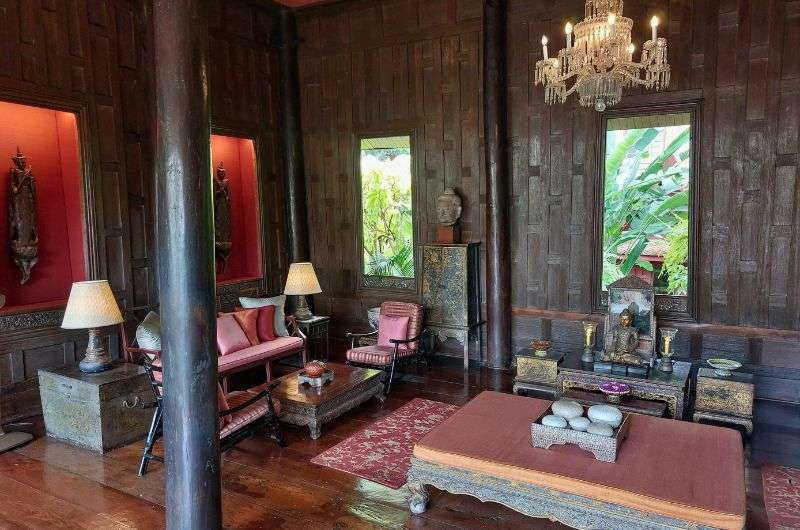
I absolutely loved Jim Thompson House!
Distance from Samsen Street Hotel: 6 km (3.8 mi), a 20-minute drive, but if you’re staying in K Maison Boutique Hotel or Vince Hotel in Pratunam, you’re much closer
Time spent there: 2 hours
Price: THB 200 (USD 5)
Opening times: 10 am–5 pm (last tour)
If you’re like me, you might find yourself debating whether the Jim Thompson House is worth a visit. Spoiler alert: it absolutely is. I loved, loved, loved this place!
First, stop by the ticket desk and get your THB 200 (USD 5) ticket and tour time—the only way to see the house is on a guided tour. Don’t worry if there’s a bit of a wait (ours was about 30 minutes), because there’s plenty to do in the meantime. Grab a coffee at the on-site café, stroll through the little garden, or check out the small art gallery housed in one of the historical wooden buildings. Just remember, the tour starts in the garden, so you’ll get another brief pass through it.
Who was Jim Thompson?
Jim Thompson was an American entrepreneur who played a pivotal role in reviving the Thai silk industry in the mid-20th century. After serving in World War II and later working for the Office of Strategic Services (OSS), the precursor to the CIA, he settled in Thailand. Fascinated by the local culture and seeing the potential in traditional Thai silk, he dedicated himself to revitalizing the industry. His efforts put Thai silk on the global map.
Thompson’s life took a mysterious turn in 1967 when he disappeared while on vacation in Malaysia. Despite extensive searches, he was never found, and his disappearance remains one of Southeast Asia’s great unsolved mysteries.
Jim Thompson house tour
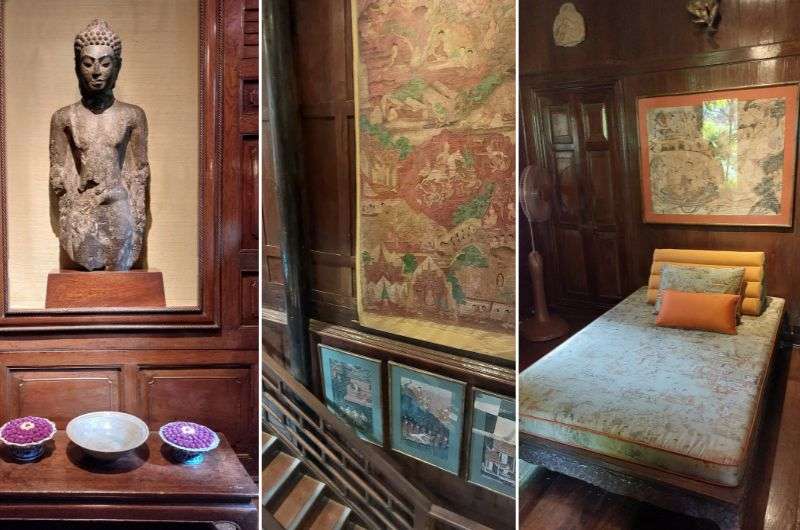
You get to see the beautiful interior of Jim Thompson House which includes some very valuable art pieces
When your tour group is called (pay attention to the number on your ticket), you gather in the reception area, get your welcomes, and head out to the garden and the ground floor of the house (the outside) for the first part of the tour.
Our guide was on her first day, but she knocked it out of the park with her storytelling and knowledge about Jim Thompson, the silk trade, and the house itself. It was interesting, though sometimes slightly hard to understand, learning about Jim’s life—his mission to revive the Thai silk industry, his eclectic tastes, and his mysterious disappearance.
When it’s time to head upstairs, you’ll stop by the lockers to leave your shoes and bags. Inside, the house is a treasure trove of statues, art, and beautiful details of the wooden house. Fun fact: traditional Thai houses never had interior staircases, but Jim’s house does, which caused quite a few raised eyebrows back in the day. There are also high steps between doorways to keep out demons and prevent babies from crawling off – practical and mystical!
You’ll see his bedroom and be challenged to figure out how he went to the bathroom (a surprisingly intriguing puzzle), marvel at a display of ceramics and some interesting home décor items, and visit the room where Jim Thompsom held meetings.
The whole tour lasts about an hour and is packed with interesting tidbits.

It wasn’t just the interiors that were interesting, the outside was just as lovely
Once you’ve soaked up all the history and charm, you’ll exit through another small museum that conveniently leads you into the gift shop. What I learned there is that silk is pricey! No souvenirs for me, boo.
Day 3, stop 2: A modern detour to Siam Paragon, Terminal 21 or CentralWorld
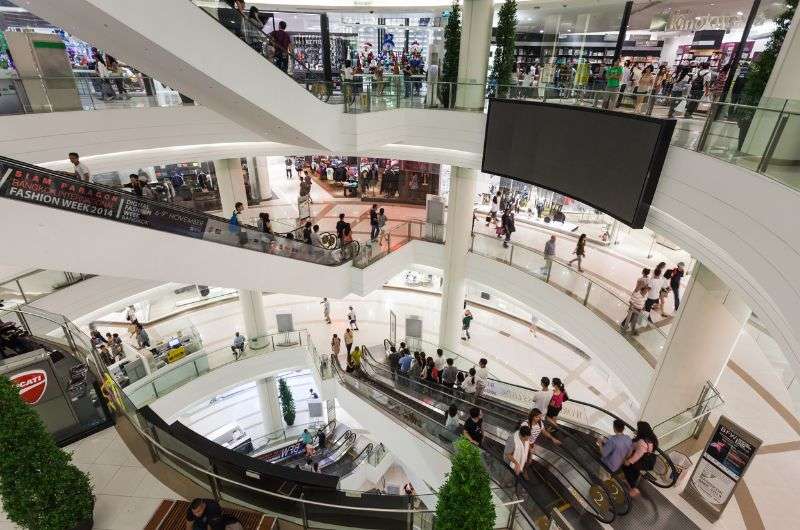
Shopping time! For example at Siam Paragon
Distance from last stop: 1.2 km (0.7 mi), a 15-minute walk to Siam Paragon (CentralWorld is right next door)
Time spent there: 2 hours–3 hours
Price: As much as your wallet can handle!
Opening times: 10 am–10 pm
Now let’s take a little detour from the cultural and historical wonders of Bangkok and dive into the city’s modern side. Even if you’re not into shopping or spending time in malls (I hear you), visiting at least one of Bangkok’s mega-malls like Siam Paragon, Terminal 21 or CentralWorld is almost mandatory to get the full picture of what Bangkok is like. Plus, you’re in the area anyway now that you’ve visited Jim Thompson House (and you’ll be hungry pretty soon, so make sure to use this stop for eating, too!).
Unlike the historic charm of the Old Town, this part of Bangkok is a whirlwind of modernity. It’s more business-y, and, yes, a bit more chaotic with all the traffic (oh, the traffic!) and bustling crowds, but at least here the ratio of tourist to local is much more balanced. Let's be honest, most of the people living in Bangkok aren't spending their days exploring Old Town. The streets are alive with energy, honking tuk-tuks, and the occasional waft of street food (or is that sewage?) mingling with other city smells. It’s a lot, but in a way that’s just electrifying and uniquely Bangkok, and precisely the reason I love this city!
Terminal 21: Terminal 21 is a shopping mall with a twist. Each floor is themed after a different international destination—think Rome, Paris, Tokyo, and more. It’s like taking a world tour without leaving Bangkok. Beyond the usual shops, you’ll find quirky décor and plenty of photo ops.
CentralWorld: CentralWorld, on the other hand, is one of the largest shopping malls in Southeast Asia. It’s a massive complex with everything from high-end boutiques to a sprawling food court and even an ice-skating rink. It’s a great spot to experience modern Bangkok and grab a bite to eat.
Siam Paragon: And then there’s Siam Paragon, the crown jewel of Bangkok’s shopping scene. This luxurious mall is a paradise for fashionistas and foodies alike. Home to high-end brands, a gourmet supermarket, and an incredible food court, Siam Paragon also boasts attractions like SEA LIFE Bangkok Ocean World, one of the largest aquariums in Southeast Asia. Whether you're window shopping or indulging in some retail therapy, the air conditioning here is a sweet, sweet relief from Bangkok’s heat. You could spend half a day here, easy.
Around these malls, you’ll also find well-maintained, landscaped areas with fountains and plazas perfect for people-watching. Grab a coffee from one of the many cafes, find a spot, and just soak in the hustle and bustle. It’s a different side of Bangkok that’s equally captivating.
After you’ve had your fill of modern Bangkok (and air conditioning), it’s time to reconnect with nature.
Day 3, stop 3: Monitor lizards at Lumpini Park and Skywalk at Benjakitti Park
Distance from last stop: 2 km (1.2 mi), a 5-minute drive to Lumpini Park
Time spent there: 3 hours
Price: 0
Opening times: 5 am–9 pm
Just a short distance from shopping heaven is Lumpini Park and the almost adjacent Benchakitti Park, together forming a green oasis in the heart of Bangkok. It’s the perfect spot to unwind and enjoy a little leisurely walk, away from the crowds, concrete, and traffic. Both parks have something to offer, so if you have the stamina, make sure to visit both.
Finding monitor lizards in Lumpini Park
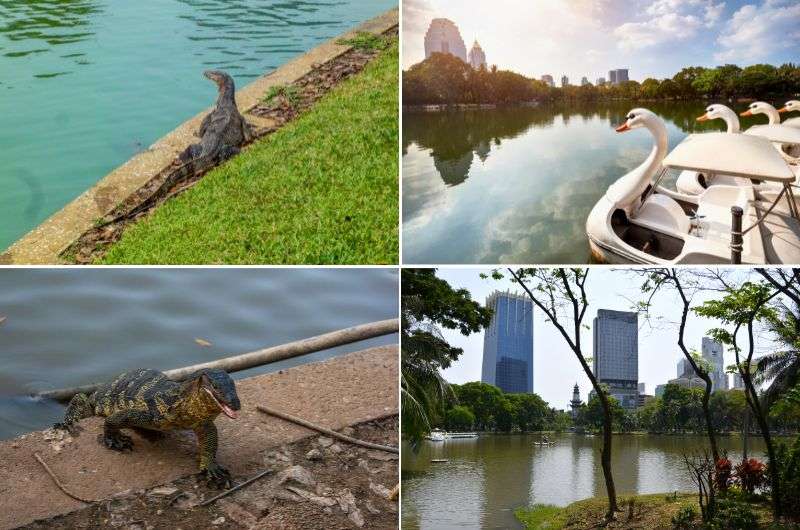
They’re not dangerous to humans, but keep your distance, because they don’t actually like us (not dangerous means they won’t kill you, but a bit would not be fun!)
At Lumpini, you’ve come to rest from the mayhem, but you won’t be totally alone: One of the park's most fascinating residents are the monitor lizards! And they’re the main reason you’re here.
These mega-sized reptiles can often be found lounging by the water or lazily swimming in the ponds. Your best bet is entering the park in the northeast corner, which is where the biggest pond is. On my last visit, I, too, went to Lumpini Park with the prime intention of finding monitor lizards, and I saw 4 within minutes of getting there—score! One junior monitor was casually walking around on the grass by the pond, and a few of his bigger buddies were in and around the water. For a European like me, seeing something so big and dinosaur-y in the wild, in the middle of a big city, is fascinating. All I know are pigeons and rats, not huge, cool-looking lizards!
In case you were wondering, no, they won’t kill you. They have a mild venom in their jaw that they use to catch their lunch with, but it wouldn’t be dangerous for a human. Monitor lizards are generally shy and tend to avoid human interaction. In Lumpini, they will ignore you as long as you give them space and pretend to ignore them too. They can look intimidating, but they generally keep to themselves, but it sure adds a bit of wild charm to your stroll.
For a small fee, you can even rent a paddle boat and enjoy a peaceful ride on the park’s lake... But now you know it’s full of monitor lizards, so maybe it won’t be so peaceful after all!
Skywalk and wetlands in Bechakitti Park
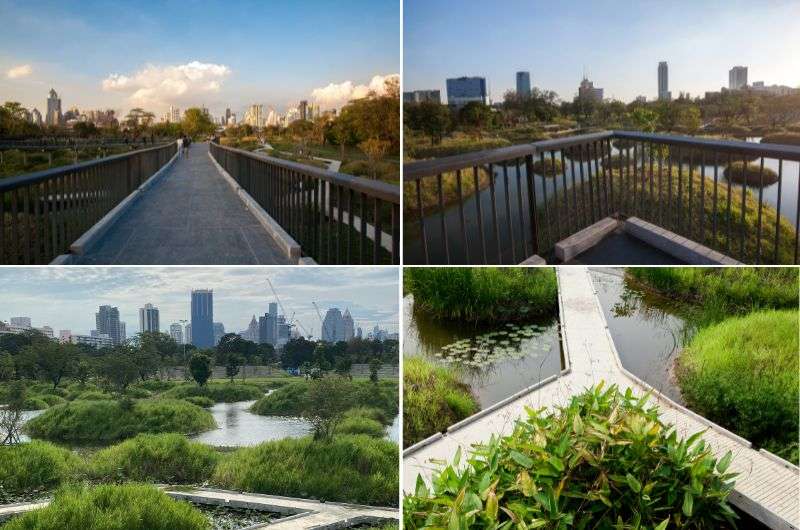
Beautiful Benchakitti Park!
Next, extend your nature walk by heading to the nearby Benchakitti Park. Again, aim for the northwestern corner, which is where you’ll find one end of the Skywalk, also called the “Green Mile”—a 1.6 km (1 mi) raised walkway that takes you through the park, namely above the wetlands that are a really cool feature within a big city, especially since you feel like you’re in the middle of a nature park, but also have endless high rise buildings visible in every direction.
Additionally, there is a ground-level pathway that winds through the park's various landscapes, including the wetland sections. Walking along these trails, you’re treated to a constantly changing scenery that never gets boring.
Day 3, stop 4: Night market
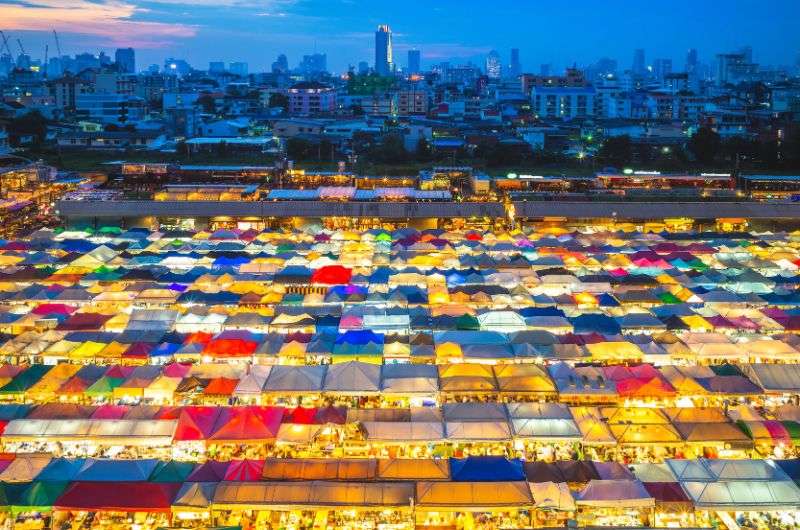
Who wants to get lost in a night market?
Distance from last stop: 3 km (1.8 mi), a 15-minute drive from Benjakitti Park to JODD FAIR Rama 9
Time spent there: 2 hours
Price: 0
Opening times: 4 pm–10 pm for JODD FAIRS Rama 9
After a day of exploring modern Bangkok and its parks, it's time to dive into the vibrant night market scene, because it’s another typically Thai experience you can’t miss (though, after your first time, you may be one and done, and that’s ok, too). Staying in the general area where you spent all day, your final stop for the day is JODD FAIRS Rama 9.
The night market called JODD FAIRS Rama 9 is open every night from 4 pm to 10 pm and it offers an authentic Thai street market experience. With countless stands selling all types of food at cheap prices, it's easy to sample a variety of dishes. Typical foods you’ll find include pad thai, grilled skewers, som tam (papaya salad), and deep-fried everything. Alongside the delicious food, enjoy live music and a bustling atmosphere. The earlier you arrive, the fewer the crowds.
Alternative: Chatuchak Weekend Market
For those visiting on weekends and feeling adventurous (or a bit masochistic), head to the massive Chatuchak Weekend Market. With over 15,000 stalls, it offers an eclectic mix of goods from antiques and clothing to electronics and pets. Yes, you read that right, pets. The market is divided into 27 sections, each specializing in different types of products. It covers 27 acres and welcomes over 200,000 visitors each weekend.
Chatuchak is a sensory overload waiting to happen; just the thought of it makes me dizzy—it’s not my vibe. You could literally get lost here for the rest of your life... or until Sunday evening when the market closes. For the full experience, you’ll need to go on weekends during the day, because it closes at 6 pm, so if you’re excited about visiting one of the largest markets in the world, you’ll need to rearrange your itinerary stops for the day. If you don’t mind a slightly less overwhelming visit, try Friday when only some stalls are open (Friday is wholesale day). Even with 7,500 vendors, it's anything but slow. You can visit Chatuchak on Fridays until closing time at midnight.
Note: Chatuchak is located in a completely different part of the city, so plan your travel time accordingly.
Next up: bed! If you went to JODDS and are staying at K Maison Boutique Hotel or Vince Hotel in Pratunam, you’re only a 15-minute drive from a shower and your beauty sleep. If you’re staying in Old Town, it’ll take about 30 minutes to get back to your hotel. Rest up, it’s almost Day 4 in Bangkok, which means your last day in the city.
Day 4 of Bangkok itinerary: Ayutthaya day trip
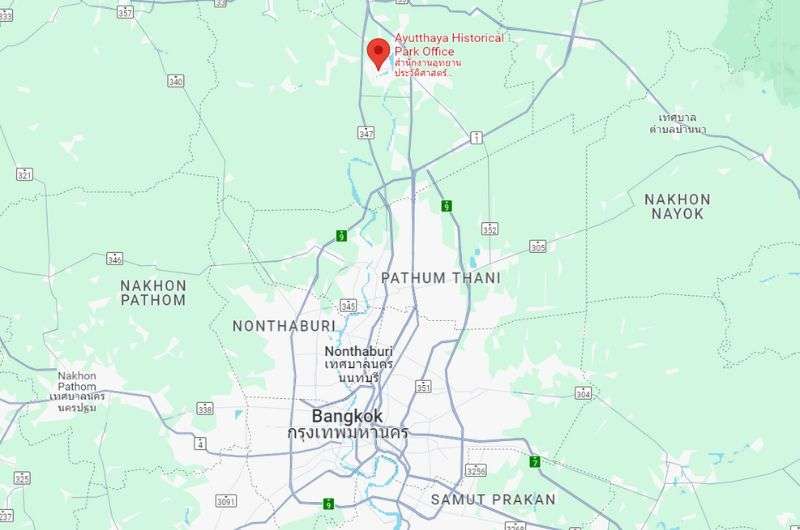
A map showing the location of Ayutthaya, the former Thai capital that you’ll be visiting on the last day of your 4-day Bangkok itinerary
Main stops on day 4: Ayutthaya, some nice bars and restaurants in the evening
Restaurant tips: lunch at one of the malls | dinner at the night market
Hotel recommendations: Samsen Street Hotel
Day 4, stop 1: Ayutthaya
Ready to step back in time? For your last day in Bangkok, you’ll head on a day trip to Ayutthaya, a UNESCO World Heritage Site and one of Thailand’s ancient capitals. Established in 1350, Ayutthaya thrived for over 400 years before being sacked by the Burmese in 1767. This historical gem is filled with impressive ruins and temples that tell the story of its glorious past.
Ayutthaya can get scorching hot, and the area is vast, so whatever you do, don’t rely solely on your own two feet to see it. Popular options include renting bicycles or hiring a tuk-tuk driver for the day (a driver should cost around THB 1,000/USD 27 for the day, or THB 200/USD 5 per hour).
When I visited a couple of years ago, I opted for a half-day tour from Bangkok, which was definitely not enough to see it all. We just got dropped off and told to walk around for a few hours before they drove us back to Bangkok, which wasn’t the best way to do it. If I were to do it again, I’d go for a full day to cover more ground and get myself some wheels.
Ayutthaya Historical Park

Ayutthaya Historical Park
The Ayutthaya Historical Park is centered around Bueng Phra Ram Park and is roughly bordered by the river that encircles the area. While many of the main temples are within or just outside this area, there are numerous other temples worth exploring beyond its boundaries. There is no entrance fee for the park, but some of the temples require a small fee to enter.
Must-visit sights within the historical park include:
- Wat Mahathat: Famous for the Buddha head entwined in tree roots.
- Wat Phra Si Sanphet: Once the royal temple, known for its iconic chedis.
- Wat Ratchaburana: Notable for its prang and detailed stucco work.
- Wat Chaiwatthanaram: A striking temple in a picturesque riverside setting.
If you get a guide or a bike, you have plenty to see further out from the main historical center. You also leave behind the main tourist crowds, which is always a nice change. For example, you could check out Wat Yai Chai Mongkhon, home to an impressive reclining Buddha statue and towering chedi.
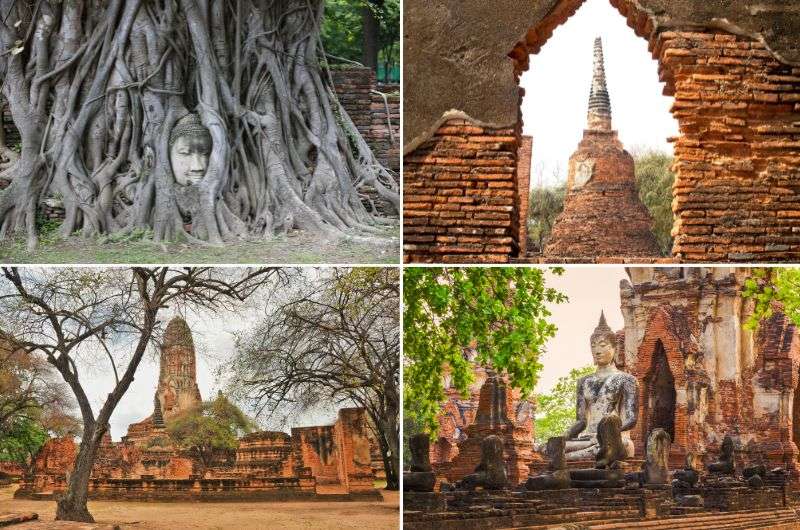
Ayutthaya provides endless exploration opportunites
And one of my favorites was Wat Phukhao Thong. This temple features a striking white chedi that had me thinking if this is what the chedi at Wat Chedi Luang in Chiang Mai looked like back in the day before it became (and impressive!) ruin—can you see the similarities? The chedi has steep stairs you can climb for amazing views. There’s even a “secret” chamber with Buddha statues accessed by a narrow tunnel up there. Plus, you'll be one of the few people that come out here, which makes it feel like you've found a hidden gem that you may have just for yourself.
Tip: If you’re approached by a group of giggling girls trying to speak English to you, give them a few minutes of your time. After a minute of uncertainty of what’s happening, I learned they are from the local school and got an assignment for their English class to go out hunting for tourists to fill in questionnaires with, to practice their English skills.
Getting to Ayutthaya
If you buy a group tour from Bangkok, then all you need to do is sit back and relax as they drive you all the way there. Tour prices are around THB 1,200 (USD 32) per person for a full day. It’s about 75 km (45 mi) from Bangkok Old Town to Ayutthaya, the drive will take about an hour.
Or, if you want to tackle Ayutthaya independently, it’s easy to do. Trains from Krung Thep Aphiwat Central Terminal (the new main train station) to Ayutthaya take about 2 hours one way and cost something silly like THB 20 (USD 0.50).
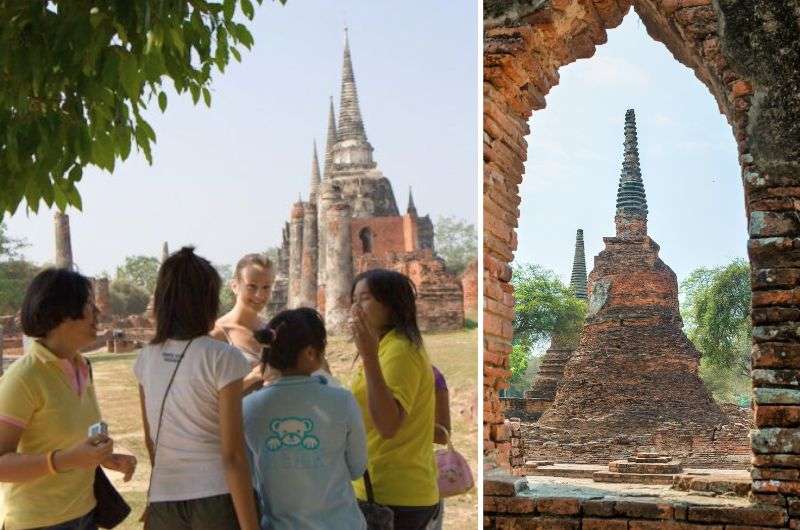
Helping these young ladies practice their English in Ayutthaya
If you’re nervous about going on your own, know that I went on a group tour and almost got left behind due to some pretty terrible instructions from our minivan driver. Picture me running around like a headless chicken trying to find the right vehicle, only to find them ready to leave without me, and getting scolded for not following instructions. I heard what I heard! Not the best way to end a day trip, but it makes for a good story! But yeah, even group tours can end up not meeting expectations.
Day 4, stop 2: Last night in Bangkok
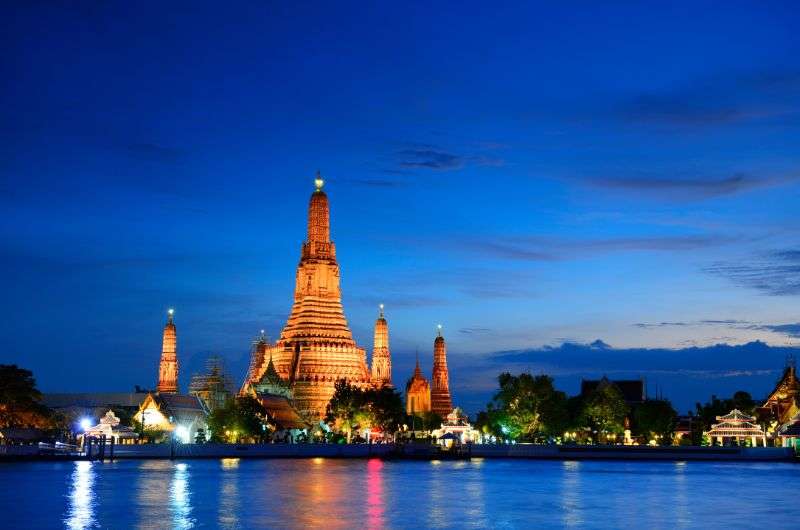
Goodbye, my beloved Bangkok! (View of Wat Arun)
Before you wave farewell to Bangkok, enjoy your last night to it’s fullest! For me, that’s hanging out at the simple streetside restaurants, but for you, it could be something a little fancier than that.
Here are a couple of options to end your Bangkok itinerary with:
Rooftop Bars:
- Lebua at State Tower: This iconic rooftop bar offers stunning panoramic views of the city skyline. Sip on a cocktail as you soak in the breathtaking scenery from one of Bangkok's highest points. I even wore lipstick and a dress that one time I went here!
- Other popular rooftops: Check out Vertigo and Moon Bar at Banyan Tree or Octave Rooftop Lounge & Bar for more sky-high experiences.
On the ground bars:
Head to the New Nana: Centered around the tiny street called Nana (not to be confused with the other Nana famous for adult entertainment!), this area is a trendy area where the cool kids hang out. Think small cocktail bars and coffee shops with intimate atmosphere, hip design, and killer drinks. Try:
- TEP Bar: Enjoy traditional Thai spirits, food, and live music.
- Teens of Thailand: Despite its name that makes it sound like it belongs in the other Nana, this is a little gin bar with a cozy atmosphere and even a few outdoor tables.
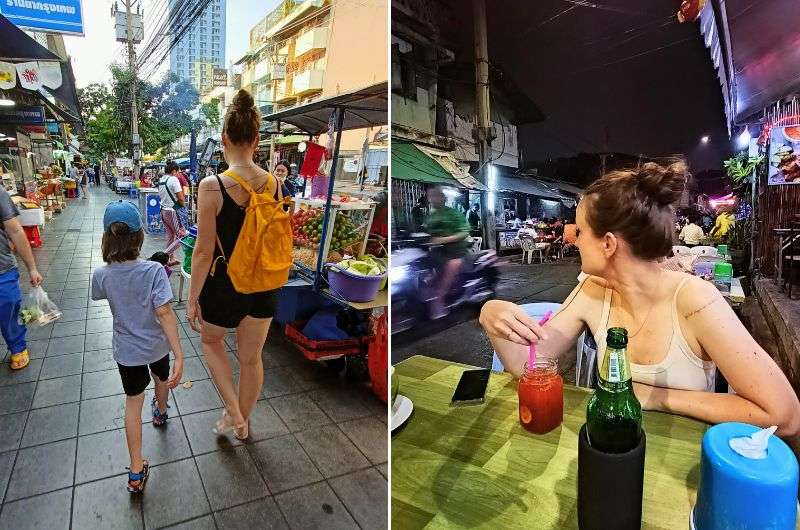
Hitting the streets is my favorite thing to do on a Bangkok evening. Everything comes alive as the sun is about to set, because it’s finally not scorching hot
Street dining:
For me, I just love hanging out on the streets, sitting in the typical plastic chairs with toilet paper that doubles as napkins, eating out on the sidewalks/roads, and soaking in the lively atmosphere. The streets just behind Samsen Street Hotel (which was awesome, by the way!) were full of bustling restaurants that were amazing. I'm not too much into fancy dining, so if you can relate, I say hit the streets!
A word on Khao San Road:
No. Just no. That’s all I have to say about that.
This post contains affiliate links. I earn a small commission if you make bookings through my links, at no additional cost to you. Thank you for your support!



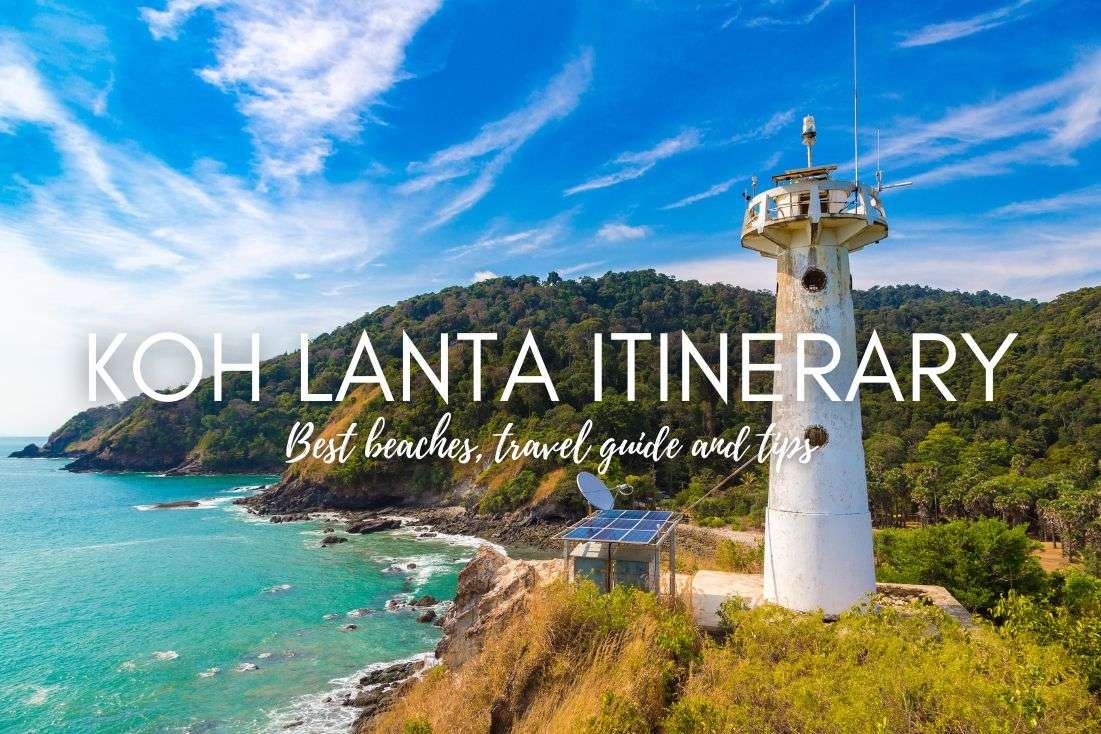
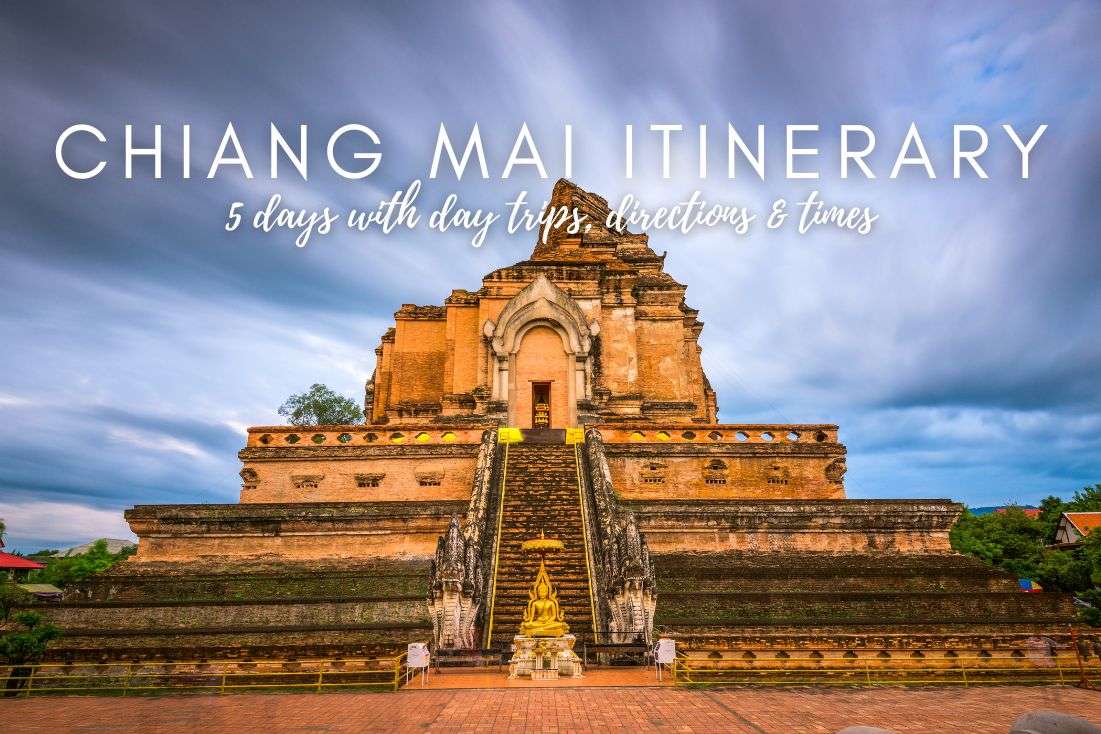





Comments | Thoughts? Give us a shout!